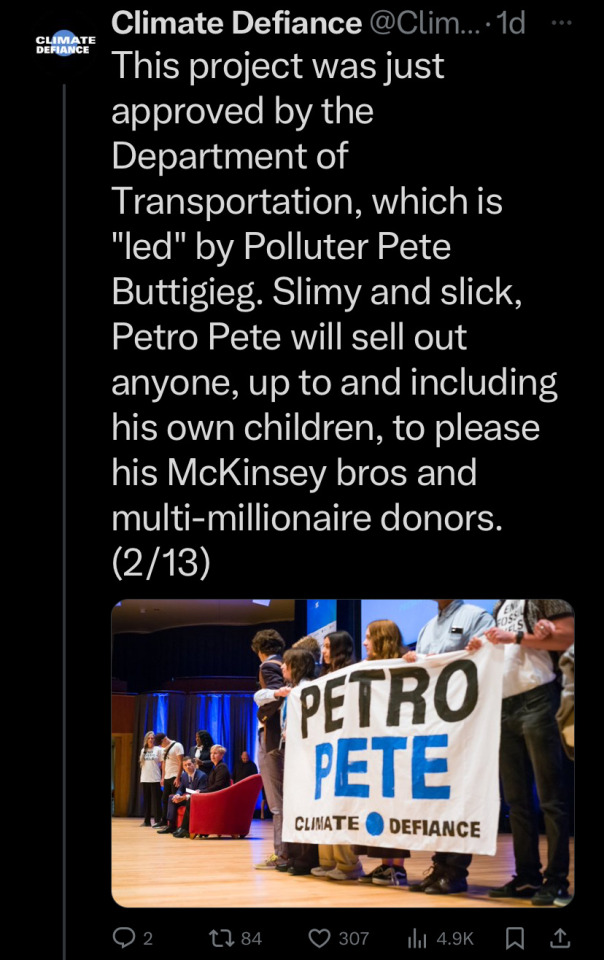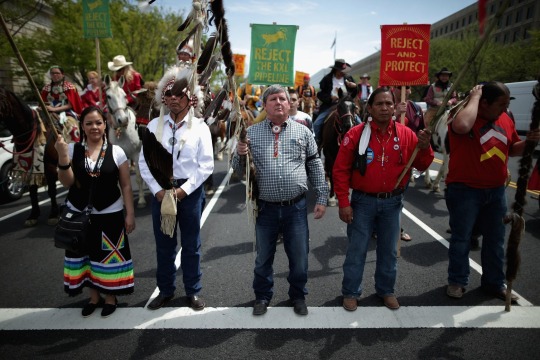#Keystone XL
Text
In their new book, Practical Radicals: Seven Strategies to Change the World, Deepak Bhargava and Stephanie Luce ... detail seven tactics that have been successfully used to change the world: base-building, disruptive movements, narrative shift, electoral changes, inside-outside campaigns, momentum, and collective care. ...
As for examples, we talk about Occupy Wall Street and the marriage equality movement. A lot of people think of Occupy Wall Street as a protest, but its largest impact was changing the narrative, changing the understanding of what was the cause of the 2008 economic crisis and what are some ways out of that crisis. ...
Sometimes flashpoints are unplanned, as with the murder of George Floyd. Sometimes people can stage big moments, as environmental activists did when they organized arrests at the Obama White House to protest the Keystone XL pipeline. Those moments are opportunities to gather thousands of activists together ... to train them in a vision and techniques of how to launch campaigns when they go back home. ...
There is cynicism about politics because it hasn’t consistently delivered material improvement in people’s lives. ... Our book features examples where electoral strategies are driven by community groups and unions that aren’t just inviting people to vote, but are inviting people to be part of organizations to work on the issues they care most about. ...
The challenges we face are so large and daunting that without many thousands of people capable of understanding the power relationships in our society and what the leverage points are, we aren’t going to win. A big hope of this book is that it ... makes strategy accessible to many more people in the years to come.
14 notes
·
View notes
Text
Genocide Joe: not content to mass murder only Palestinians!




#genocide joe#climate change#democrats#politics#us politics#environment#coal#big oil#keystone xl#sea port oil terminal#news#social justice#climate justice
2 notes
·
View notes
Text
Keystone Pipeline oil spill under investigation
Keystone Pipeline oil spill under investigation
Keystone Pipeline oil spill under investigation – CBS News
Watch CBS News
The cause of a Keystone Pipeline oil spill is under investigation after it spewed an estimated 590,000 gallons into a creek in rural Kansas last week. The environmental disaster may impact gas prices. Omar Villafranca has more details.
Be the first to know
Get browser notifications for breaking news, live events, and…
View On WordPress
0 notes
Text
According to documents obtained by Grist and Type Investigations through a Freedom of Information Act request, the FBI’s Minneapolis office opened a counterterrorism assessment in February 2012, focusing on actions in South Dakota, that continued for at least a year and may have led to the opening of additional investigations. These documents reveal that the FBI was monitoring activists involved in the Keystone XL campaign about a year earlier than previously known.
Their contents suggest that, long before the Keystone and Dakota Access pipelines became national flashpoints, the federal government was already developing a sweeping law enforcement strategy to counter any acts of civil disobedience aimed at preventing fossil fuel extraction. And young, Native activists were among its first targets.
“The threat emerging … is evolving into one based on opposition to energy exploration related to any extractions from the earth, rather than merely targeting one project and/or one company,” the FBI noted in its description of the Wanblee blockade.
The 15-page file, which is heavily redacted, also describes Native American groups as a potentially dangerous threat and likens them to “environmental extremists” whose actions, according to the FBI, could lead to violence. The FBI acknowledged that Native American groups were engaging in constitutionally protected activity, including attending public hearings, but emphasized that this sort of civic participation might spawn criminal activity.
To back up its claims, the FBI cited a 2011 State Department hearing on the pipeline in Pierre, South Dakota, attended by a small group of Native activists. The FBI said the individuals were dressed in camouflage and had covered their faces with red bandanas, “train robber style.” According to the report, they were also carrying walking sticks and shaking sage, claiming to be “Wounded Knee Security of/for Mother Earth.”
“The Bureau is uncertain how the NA group(s) will act initially or subsequently if the project is approved,” the agency wrote.
The FBI also singled out the “Native Youth Movement,” which it described as a mix between a “radical militia and a survivalist group.” In doing so, it appeared to conflate a specific activist group originally founded in Canada in the 1990s with the broader array of young Native activists who opposed the pipeline decades later. Young activists would play an important role in the Keystone XL campaign and later on during protests against the Dakota Access pipeline at Standing Rock, but the movement had little in common with militias or survivalists, terms typically used to describe far-right groups or those seeking to disengage from society.
The FBI declined to respond to questions for this story. In an emailed statement, a spokesperson for the Minneapolis field office said the agency does not typically comment on FOIA releases and “lets the information contained in the files speak for itself.”
[...]
Environmental activists and attorneys who reviewed the new documents told Grist and Type Investigations that law enforcement’s approach to the Keystone XL campaign looked like a template for the increasingly militarized response to subsequent environmental and social justice campaigns — from efforts to block the Dakota Access pipeline at Standing Rock to the ongoing protests against the police training center dubbed “Cop City” in Atlanta, Georgia, which would require razing at least 85 acres of urban forest.
The FBI’s working thesis, outlined in the new documents, that “most environmental extremist groups” have historically moved from peaceful protest to violence has served as the basis for subsequent investigations. “It’s astonishing to me how such a broad concept basically paints every activist and protester as a future terrorist,” said Mike German, a former FBI special agent who is now a fellow at the nonprofit Brennan Center for Justice.
255 notes
·
View notes
Text
"Someone needs to explain to me why wanting clean drinking water makes you an activist, and why proposing to destroy water with chemical warfare doesn't make a corporation a terrorist."
—Winona LaDuke, "Canadian Oil Companies Trample on Our Rights" (2013)
#environmentalism#winona laduke#indigenous rights#keystone xl pipeline#canada#south dakota#capitalism
5 notes
·
View notes
Text
This happened an hour and a half north of my alma mater. I find it hard to believe that there was "no impact" on the local drinking water. This was the exact thing Indigenous Peoples were fighting to prevent. They knew this was only a matter of time.

#keystone xl pipeline#end fossil fuels#big oil is evil#oil spill#kansas#indigineous people#this was preventable#ad astra per aspera#oil and gas#they want us dead#profits over people#fuck big oil#unacceptable#accountability now
27 notes
·
View notes
Text
ok with all the good things biden's administration has been doing or tried to do yall americans BETTER fucking not pull out that same motherfucking 'both sides are equally bad' bullshit when voting comes around.
#trump tried to bring back the keystone xl pipeline and biden nixed it again#so dont fucking even tell me the gop cant do terrible damage and that biden has done nothing at all#i am so so so fucking sick of doomers who think that not participating in the system is the right thing to do#change is not fast! change will never be fast!#even if/when your glorious revolution happens you know how long it will take to build everything up afterwards???#fucking shut up and go vote#i am so over le epic revolutionists#ESPECIALLY with all the project 2025 bullshit#no politician is perfect#but i would rather have the one that stood on a picket line than the one who STARTED A COUP
2 notes
·
View notes
Video
youtube
On Waterbear. About the Keystone XL Pipeline. Video is about 28 minutes long.
6 notes
·
View notes
Text
I was talking to lex and kk the other day & they were baffled I didn’t remember being in a storm & getting crepes with them & I’m like :)? yeah I don’t remember much I outsource almost all my memories so thanks for this one it sounds pretty good
#my ramblings#give me a second to be insane and too transparent#I know the reason I really like narratives about character consistency a lot#like those kind of cyclical stories where the character reaffirms their actions and beliefs after being put into different situations#(tgcf sticks out in terms of xl ending in the same ideological place with greater understanding and conviction)#is because I had a huge thing with memory and identity and every few months or years I’d have a whole ass identity crisis#and then I just kinda stopped#and I’m guessing it’s because even though it felt like I was rehashing the same thing over and over again#I must’ve been making some minute progress every cycle until it got resolved#not that I remember it??? lol#haha past stella does all the work and present stella coasts#keystone to my convoluted unwavering faith in myself :)
4 notes
·
View notes
Photo

#fjb#lgbtpeople#lgb#LGBT#Red Piper Communications#redpipercommunications#society#grooming#DumpDisney#MakeDisneyFamilyFriendlyAgain#CancelDisney+#CancelDisney#keystone xl pipeline#xl#keystone#elon musk#elon twitter
2 notes
·
View notes
Link
Americans know that Biden is old, frail, and unable to effectively communicate. Without oratory skills, Biden cannot lead or inspire Americans. Read more.
0 notes
Text
The Who of Hua Cheng
I am going to venture a guess that I spend more time than at least 99% of the population thinking deeply about Hua Cheng (not that hard but the brain rot is still real).
I find myself turning around and around in my mind the who of Hua Cheng, because TGCF is written from Xie Lian's point of view. We see moments with him, which are keystone moments in Hua Cheng's life for certain, but are brief compared to the rest.
And sometimes I worry that we don't think enough about Hua Cheng as a fully fleshed person. Is he a supreme because of XL? Absolutely he is. But all the rest of the things about him are very much inherently him.
It means that tiny Hong'er was extremely smart even when marked with the curse. And that Hong'er was tenacious too. It meant that Hong'er had martial prowess great enough to ascend, all on his own. In another world (one where he was not born under the Star of Solitude), Hong'er would be a god.
I think it bears mentioning that even in spite of being born under such a curse, all he needed to reach the heights he was destined to reach was the kindness of a single person: Xie Lian.
Was Xie Lian his totem? Absolutely! But the thing about being devout is that it comes from within. Hua Cheng's strength is not something he borrows from Xie Lian. It's not something he depends on Xie Lian for in order to flourish and grow.
And I think that's important.
Hua Cheng is very much his own person. He's made thousands and thousands of choices in his life. Are they choices that he weighs based on what his god would do? Yes, very much. But he does not depend on Xie Lian to make those choices.
He made Ghost City in part to curb the worst instincts of people. And he also made it to give wayward wanderers with nowhere to go a place to call home.
He answers the prayers of children going to his temples over rich folks.
He made a teleportation array that serves half as a prank to people who use it.
All while searching for his vagabond god.
Don't get me wrong, this does not mean that he would not give each and every piece of himself to Xie Lian once the two were reunited. And those other things he did are truly secondary to his vow to love and protect his god, but I don't think we should forget how extraordinary Hua Cheng is, even in the secondary.
Xie Lian fell in love with Hua Cheng so easily because of the person he was. He's clever, and he's funny, and he's kind (even if he denies it), and he's a martial master. He was these things independent of Xie Lian, but because of Xie Lian's moment of kindness, he was also not robbed of sharing those parts of him with the world.
Hua Cheng and Xie Lian truly belong together. Not because Hua Cheng is devoted, but because Hua Cheng is amazing.
#tgcf meta#hualian#hua cheng is the best#hua cheng's true potential#heaven official's blessing meta#the who of hua cheng
267 notes
·
View notes
Text
By JON QUEALLY
Common Dreams
Sep 09, 2023
"The Corps' covering for the pipeline company's outrageous safety record and the reviewer's serious conflict of interest have now resulted in a failed effort," said Standing Rock Sioux Tribe Chairwoman Janet Alkire. "They need to start over with adult supervision."
Standing Rock Sioux Tribe Chairwoman Janet Alkire is leading a fresh demand that the U.S. Army Corps of Engineers throw out an ongoing environmental review process of the controversial Dakota Access Pipeline and start again from scratch alongside a superseding call for the pipeline to be shuttered completely.
Following Friday's release of a revised Environmental Impact Statement (EIS), ordered by a federal court, the tribe said the document reveals the entire process has been a failure and that the pipeline—currently operating across their land without consent in what they consider an "illegal" manner by the Energy Transfer company—should be shut down once and for all.
"We're furious that the Army Corps has addressed none of our major concerns during the review process," Chairwoman Alkire said in a statement.
"The pipeline is an imminent threat to the Missouri River, sensitive habitat, and sacred burial sites along the riverbank," she continued. "The oil company's emergency response plans are inadequate, its safety track record is horrendous, and there's been a stunning lack of transparency with Standing Rock throughout the environmental review process, including inaccurate characterizations of tribal consultation."
The Army Corps did not make any recommendations or indicate preferences among the alternatives presented in the new EIS report, which included keeping it in operation, possible rerouting, removing the pipeline by excavation, or abandoning it in place. The Corps said its final recommendations will accompany a final report once the review process is complete, but the Standing Rock Sioux said the process has been seriously flawed.
The tribe said the draft EIS fails to "account for the existence of criminal charges and a host of fines and serious citations" from regulators faced by Energy Transfer. Alkire accused the Corps of "doing all it can to ignore the company’s poor safety record and the high risk" of the pipeline. According to the statement by the tribe:
the entirety of the environmental review process hasn't been taken seriously and is compromised because the Corps selected a company with a clear conflict of interest to prepare the just-released draft EIS. Environmental Resources Management — which also produced a sparkling environmental review for the Keystone XL pipeline, later shelved due to environmental concerns — is a member of the American Petroleum Institute. That organization previously filed a legal brief in support of DAPL in Standing Rock’s suit against the Army Corps.
Moreover, Environmental Resources Management has contracted with at least five separate companies with an ownership interest in DAPL.
The release of the EIS triggers a 45-day public comment period and the Standing Rock Sioux Tribe is now requesting public support in opposition of the project.
"The Corps' covering for the pipeline company's outrageous safety record and the reviewer's serious conflict of interest have now resulted in a failed effort," said Alkire of the current process. "They need to start over with adult supervision."
Amy Mall, senior advocate at NRDC, said her group stands "in solidarity with the Standing Rock Sioux Tribe in opposing this dirty and dangerous pipeline that harms the climate and threatens the primary water source for the Tribe."
"The Army Corps must consider all of the risks of this pipeline, make all significant environmental information available without redactions, and honor the Tribe’s treaty rights," Mall added. "We call on the Corps to shut it down."
Our work is licensed under Creative Commons (CC BY-NC-ND 3.0). Feel free to republish and share widely.
JON QUEALLY
Jon Queally is managing editor of Common Dreams.
Full Bio >
#standing rock sioux tribe#dakota access pipeline#u.s. army corps of engineers#fossil fuels#climate crisis#climate change#NRDC
116 notes
·
View notes
Text
"The Canadian company said in a statement that it did so for safety reasons. But drone footage of the spill — the largest in the pipeline’s history — was among the only means of seeing the damage as the site is closed to press. Even lawmakers were not allowed there for a briefing."
Nothing to see here, folks. Trust us, the Oil Barons r*ping the environment.

#keystone xl pipeline#end fossil fuels#big oil is evil#fuck big oil#environment#environmental issues#accountability now#profits over people#ad astra per aspera#kansas#free press#journalism#obstruction#oil spill#oil and gas
0 notes
Photo

On this day, 9 June 2021, it was announced that the proposed Keystone XL oil pipeline, which would have carried petroleum over 1000 miles from tar sands in Canada to Nebraska, was to be scrapped. First Nations peoples in Canada had resisted oil extraction in the region for years, and were joined by Native Americans in the United States in opposing the pipeline. These included the Sicangu Lakota Oyate, Assiniboine, Aaniiih and Nez Perce peoples. Native American protests also inspired resistance from other environmentalists, who began a campaign of civil disobedience against the project. The pipeline was first scrapped by the administration of Barack Obama, but then resurrected by later president, Donald Trump. Following renewed protests, the project was finally scrapped by the administration of Joe Biden. The campaign was one of many Indigenous struggles over land, sovereignty, and the environment which has contributed significantly to the fight against climate change. One study found that Indigenous resistance in United States and Canada has helped prevent 12% of the combined carbon dioxide equivalent pollution of the countries. Learn more about Native American resistance in this book: https://shop.workingclasshistory.com/products/500-years-of-indigenous-resistance-gord-hill To access this hyperlink, click our link in bio then click this photo https://www.facebook.com/photo.php?fbid=641244214715464&set=a.602588028581083&type=3
193 notes
·
View notes

